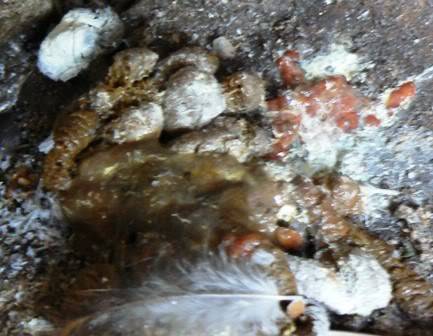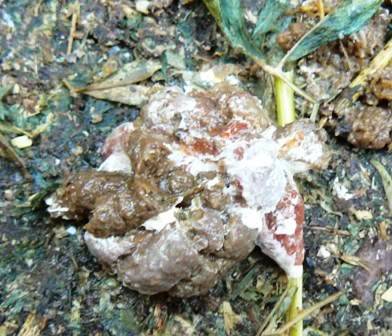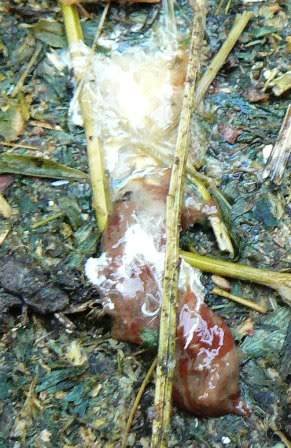Coccidiosis
Page 1 of 1
 Coccidiosis
Coccidiosis
The disease Coccidiosis is caused by parasitic Protozoa. Most coccidia in poultry belong to the genus Eimeria. It is common worldwide, but is especially likely in warm, humid weather. It is also common in younger or growing birds. There are many strains, and birds can be affected by different strains at the same time, or in succession. Coccidia causes disease in chickens, turkeys, geese and ducks where they develop in the intestinal tissues.
Birds that have coccidiosis often display a characteristic posture. They hunch up, fluff up and can drop their wings. They may have:
The disease is spread by droppings of infected birds. It can be spread on used equipment, feed containers, feet of humans and wild birds etc.
There are two main types of Coccidiosis – Intestinal Coccidiosis and Cecal Coccidiosis. In the intestinal version the intestinal tract is affected by the Eimeria, and in the Cecal version, the cecum is affected.
Coccidia have two main phases in their life cycle; one phase occurs outside the host and involves the development of the infective stages (oocysts), and the major phase which occurs within the host and involves massive multiplication and sexual reproduction.
Birds ingest a number of oocysts and become infected. The severity of the infection depends on the numbers that they are host to. At a low dose the immune systems responds to the challenge and deals with the infection. When birds ingest too many they can develop visible symptoms and if the disease is unchecked it can kill them.
Incubation period
Cecal Coccidiosis: 5 – 6 days
Intestinal Coccidiosis: 5 days
Diagnosis
flock history, postmortem findings, fecal test (presence of oocysts in fecal specimen).
Treatment
Treat urgently with a medication for Coccidiosis according to directions. Raise chicks on clean dry litter and avoid crowded or damp conditions. Make sure drinkers are not spilling water into the litter. Make sure water and feed is uncontaminated by droppings. Use medicated chick starter or grower. Ensure that chicks are warmly housed out of draughts. In severe cases raising chicks on a wire grill can reduce ingestion of the oocysts and help recovery. In severe cases, reducing the protein level in the feed can also be of assistance. Monitor droppings during and after treatment. Often morning droppings can show blood, even if the day is normal. Putting newspaper under perches or on brooder floors can make the droppings easier to see.
Follow treatment with a vitamin supplement (especially A and K).
Survivors of one strain may become infected with a different strain and require further treatment. Survivors of severe infections may never be productive.
Common Medications (many available at local produce stores):
Sulphaquin (Sulphaquinoxaline)
Sulpha D (sulfadiazine)
Sulpha 3 (Sulphaquinoxaline+Sulphadimidine+Sulphathiazole)
Sulphadim (Sulphadimione)
Baycox (Toltrazuril)
Coccivet (Amprolium, Ethopabate)
Amprolium
Anticoccidial drugs fall into two categories – coccidiostats, and coccidiocides.
Medications are either coccidicidal (cidal), which means they kill the parasite, or coccidiostatic (static), which do not kill the parasites, but arrest their development.
Coccidiostats are given in the feed to prevent severe outbreaks of the disease. The coccidiostat doesn't actively kill the coccidia, it simply interrupts the breeding cycle and they can't multiply into large numbers. The coccidiostat can be included in starter and grower crumbles and can be seen on the label. Old or poorly mixed feed may not be reliable as a preventive.
Medications that are given to treat coccidiosis (therapeutic therapy) are coccidiocides. They actively kill the protozoa. Sulphaquin and Baycox would fall into this category. These drugs are usually given in the drinking water. The chickens must ingest enough of the coccidiocide to be effective. Early treatment is very important because the coccidiocide must kill the coccidia within the bird before irrepairable damage is done to the intestines. Thee are also some medications that can act as both a coccidiostat and a coccidiocide.
The dosage rates of coccidiocides are carefully balanced to kill enough of the coccidia to save the bird, yet still enable immunity to develop. Overdosing can be toxic to the birds, so in treating for coccidiosis more is not better. Treatment needs to take place urgently once symptoms are seen as a bird can die within a couple of days in severe cases.
Vaccine
Commercial vaccines consist of low doses of live, sporulated oocysts of the various coccidial species administered at low doses to day-old chicks. These are not widely used among backyarders due to difficulty in obtaining the vaccine, and the fact that good management makes it unnecessary.
Immunology
Birds of any age can be susceptible to coccidiosis, although in practice, most acquire infection in the first few weeks of life and this infection induces a good immunity. In most situations this persists for life because of frequent low-grade re-exposure to infection, but in the absence of infection, immunity may wane. Immunity is species specific. So, for example, immunity to Emeria Maxima does not confer resistance to E. tenella and so on. Immunity is best engendered by repeated exposure to low numbers of oocysts, so-called 'trickle' infection, and this is what usually takes place naturally.
Epidemiology
The severity of the disease is dependent on both the species of Eimeria and the size of the infecting dose of oocysts. It is impossible to produce a coccidia-free environment under normal conditions and chicks will quickly become infected. Usually immunity will be acquired without clinical disease occurring, oocyst output will be reduced and litter occyst populations fall rapidly. However if the balance is disturbed by factors which favour the parasite, such as an initial high degree of environmental contamination and/or ideal sporulation conditions (e.g. wet litter) pathogenic numbers of infective oocysts will be ingested by non-immune birds and disease will result. It's typical to see this with chicks on litter at about 3-6 weeks of age.
Sources:
The Chicken Health Handbook by Damerow, G
Poultry Diseases (3rd ed) by Jordan, FTW
Poultry Diseases edited by RF Gordon
Veterinary Pathology by Jones (5th ed) by Jones TC & Hunt RD

A dropping produced after a week of treatment with Sulphaquin.


These poops are from a group of 12 week old birds with a case of cocci

These pics are a bit later on, after treatment has started:






Birds that have coccidiosis often display a characteristic posture. They hunch up, fluff up and can drop their wings. They may have:
- diarrhea
soft mucoid faeces
bloody droppings
pink intestinal tissue in droppings
hunched posture with ruffled feathers
droopiness
loss of appetite or even interest in water
slow growth
weakness
aenemia - may see pale comb and skin
The disease is spread by droppings of infected birds. It can be spread on used equipment, feed containers, feet of humans and wild birds etc.
There are two main types of Coccidiosis – Intestinal Coccidiosis and Cecal Coccidiosis. In the intestinal version the intestinal tract is affected by the Eimeria, and in the Cecal version, the cecum is affected.
Coccidia have two main phases in their life cycle; one phase occurs outside the host and involves the development of the infective stages (oocysts), and the major phase which occurs within the host and involves massive multiplication and sexual reproduction.
Birds ingest a number of oocysts and become infected. The severity of the infection depends on the numbers that they are host to. At a low dose the immune systems responds to the challenge and deals with the infection. When birds ingest too many they can develop visible symptoms and if the disease is unchecked it can kill them.
Incubation period
Cecal Coccidiosis: 5 – 6 days
Intestinal Coccidiosis: 5 days
Diagnosis
flock history, postmortem findings, fecal test (presence of oocysts in fecal specimen).
Treatment
Treat urgently with a medication for Coccidiosis according to directions. Raise chicks on clean dry litter and avoid crowded or damp conditions. Make sure drinkers are not spilling water into the litter. Make sure water and feed is uncontaminated by droppings. Use medicated chick starter or grower. Ensure that chicks are warmly housed out of draughts. In severe cases raising chicks on a wire grill can reduce ingestion of the oocysts and help recovery. In severe cases, reducing the protein level in the feed can also be of assistance. Monitor droppings during and after treatment. Often morning droppings can show blood, even if the day is normal. Putting newspaper under perches or on brooder floors can make the droppings easier to see.
Follow treatment with a vitamin supplement (especially A and K).
Survivors of one strain may become infected with a different strain and require further treatment. Survivors of severe infections may never be productive.
Common Medications (many available at local produce stores):
Sulphaquin (Sulphaquinoxaline)
Sulpha D (sulfadiazine)
Sulpha 3 (Sulphaquinoxaline+Sulphadimidine+Sulphathiazole)
Sulphadim (Sulphadimione)
Baycox (Toltrazuril)
Coccivet (Amprolium, Ethopabate)
Amprolium
Anticoccidial drugs fall into two categories – coccidiostats, and coccidiocides.
Medications are either coccidicidal (cidal), which means they kill the parasite, or coccidiostatic (static), which do not kill the parasites, but arrest their development.
Coccidiostats are given in the feed to prevent severe outbreaks of the disease. The coccidiostat doesn't actively kill the coccidia, it simply interrupts the breeding cycle and they can't multiply into large numbers. The coccidiostat can be included in starter and grower crumbles and can be seen on the label. Old or poorly mixed feed may not be reliable as a preventive.
Medications that are given to treat coccidiosis (therapeutic therapy) are coccidiocides. They actively kill the protozoa. Sulphaquin and Baycox would fall into this category. These drugs are usually given in the drinking water. The chickens must ingest enough of the coccidiocide to be effective. Early treatment is very important because the coccidiocide must kill the coccidia within the bird before irrepairable damage is done to the intestines. Thee are also some medications that can act as both a coccidiostat and a coccidiocide.
The dosage rates of coccidiocides are carefully balanced to kill enough of the coccidia to save the bird, yet still enable immunity to develop. Overdosing can be toxic to the birds, so in treating for coccidiosis more is not better. Treatment needs to take place urgently once symptoms are seen as a bird can die within a couple of days in severe cases.
Vaccine
Commercial vaccines consist of low doses of live, sporulated oocysts of the various coccidial species administered at low doses to day-old chicks. These are not widely used among backyarders due to difficulty in obtaining the vaccine, and the fact that good management makes it unnecessary.
Immunology
Birds of any age can be susceptible to coccidiosis, although in practice, most acquire infection in the first few weeks of life and this infection induces a good immunity. In most situations this persists for life because of frequent low-grade re-exposure to infection, but in the absence of infection, immunity may wane. Immunity is species specific. So, for example, immunity to Emeria Maxima does not confer resistance to E. tenella and so on. Immunity is best engendered by repeated exposure to low numbers of oocysts, so-called 'trickle' infection, and this is what usually takes place naturally.
Epidemiology
The severity of the disease is dependent on both the species of Eimeria and the size of the infecting dose of oocysts. It is impossible to produce a coccidia-free environment under normal conditions and chicks will quickly become infected. Usually immunity will be acquired without clinical disease occurring, oocyst output will be reduced and litter occyst populations fall rapidly. However if the balance is disturbed by factors which favour the parasite, such as an initial high degree of environmental contamination and/or ideal sporulation conditions (e.g. wet litter) pathogenic numbers of infective oocysts will be ingested by non-immune birds and disease will result. It's typical to see this with chicks on litter at about 3-6 weeks of age.
Sources:
The Chicken Health Handbook by Damerow, G
Poultry Diseases (3rd ed) by Jordan, FTW
Poultry Diseases edited by RF Gordon
Veterinary Pathology by Jones (5th ed) by Jones TC & Hunt RD

A dropping produced after a week of treatment with Sulphaquin.


These poops are from a group of 12 week old birds with a case of cocci

These pics are a bit later on, after treatment has started:






Page 1 of 1
Permissions in this forum:
You cannot reply to topics in this forum
